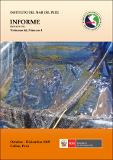Por favor, use este identificador para citar o enlazar este ítem:
https://hdl.handle.net/20.500.12958/3383Registro completo de metadatos
| Campo DC | Valor | Lengua/Idioma |
|---|---|---|
| dc.contributor.author | Rebaza Castillo, Víctor | - |
| dc.contributor.author | Alfaro Mudarra, Santos | - |
| dc.contributor.editor | Instituto del Mar del Perú | - |
| dc.date.accessioned | 2019-12-24T15:48:38Z | - |
| dc.date.available | 2019-12-24T15:48:38Z | - |
| dc.date.issued | 2019 | - |
| dc.identifier.citation | Inf Inst Mar Perú 46(4), 2019,p.517-556 | es_ES |
| dc.identifier.issn | 0378-7702 | - |
| dc.identifier.uri | https://hdl.handle.net/20.500.12958/3383 | - |
| dc.description.abstract | En la Región La Libertad, en junio 2016, se monitoreó la calidad del ambiente marino costero de Pacasmayo, Malabrigo y Huanchaco-Salaverry, abarcando la zona submareal, intermareal y los ríos Jequetepeque, Moche y Virú (Puerto Morín). Se midieron parámetros físicos y químicos, nutrientes y trazas de metales pesados en sedimento y análisis biológicos. El monitoreo se desarrolló en condiciones oceanográficas neutras. Prevalecieron las Aguas Costeras Frías (ACF) con rezagos de Aguas Subtropicales Superficiales (ASS), así como, aguas de origen continental en la zona intermareal. La calidad del ambiente marino costero en orden decreciente fue Pacasmayo, Malabrigo y Huanchaco-Salaverry; mayor población y desarrollo económico-social reflejaron altas concentraciones de agentes contaminantes físicos, químicos y biológicos. El contenido de metales ecotóxicos que se encontraron en sedimentos superficiales marinos en orden decreciente fueron zinc > plomo > cadmio > mercurio. Los promedios fueron 100,64; 20,83; 1,92 y 0,09 mg/kg, respectivamente. Excepto por el mercurio, las tres zonas presentaron un incremento, entre 12 y 25% con respecto a diciembre 2015. En Huanchaco-Salaverry las concentraciones de los cuatro metales ecotóxicos, de acuerdo con las categorías ISQG y PEL de la Norma de Canadá, indicaron efectos biológicos adversos ocasionales. | es_ES |
| dc.description.abstract | ABSTRACT: the quality of the coastal marine environment of Pacasmayo, Malabrigo, and Huanchaco-Salaverry, in the La Libertad Region, was monitored by covering the subtidal and intertidal zones and the Jequetepeque, Moche, and Virú Rivers (Puerto Morín). Physical and chemical parameters, nutrients and traces of heavy metals were measured in sediment and biological analysis. Monitoring was carried out under neutral oceanographic conditions. Cold Coastal Waters (CCW) predominated with Surface Subtropical Waters (SSW), as well as waters of continental origin in the intertidal zone. The quality of the coastal marine environment in decreasing order was Pacasmayo, Malabrigo, and Huanchaco-Salaverry; greater population and economic-social development reflected high concentrations of physical, chemical, and biological pollutants. The content of ecotoxic metals found in marine surface sediments in decreasing order were zinc > lead > cadmium > mercury. The averages were 100.64, 20.83, 1.92, and 0.09 mg/kg, respectively. Aside from mercury, all three zones showed an increase, between 12 and 25% as compared to December 2015. In Huanchaco-Salaverry the concentrations of the four ecotoxic metals, according to the ISQG and PEL categories of the Canadian Standard, indicated occasional adverse biological effects. | - |
| dc.language.iso | spa | es_ES |
| dc.publisher | Instituto del Mar del Perú | es_ES |
| dc.relation.ispartofseries | Informe IMARPE;46(4), 2019 | - |
| dc.rights | info:eu-repo/semantics/openAccess | es_ES |
| dc.rights.uri | https://creativecommons.org/licenses/by/4.0/ | es_ES |
| dc.source | Instituto del Mar del Perú - IMARPE | es_ES |
| dc.source.uri | Repositorio Digital IMARPE | es_ES |
| dc.subject | Evaluación de los parámetros físicos, químicos y biológicos en agua, sedimento y organismos marinos | es_ES |
| dc.subject | Niveles de contaminación | es_ES |
| dc.subject | Ecosistema marino costero en La Libertad | es_ES |
| dc.title | Ambiente marino costero de La Libertad, Perú en junio 2016 | es_ES |
| dc.title.alternative | Coastal marine environment of La Libertad, Peru, June 2016 | es_ES |
| dc.type | info:eu-repo/semantics/article | es_ES |
| Aparece en las colecciones: | Informe vol. 46(4) 2019 | |
Ficheros en este ítem:
| Fichero | Descripción | Tamaño | Formato | |
|---|---|---|---|---|
| Informe 46(4)-3.pdf | 3,85 MB | Adobe PDF |  Visualizar/Abrir |
Este ítem está sujeto a una licencia Creative Commons Licencia Creative Commons

